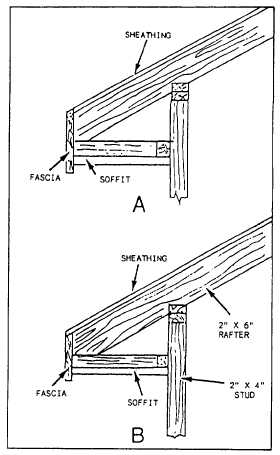Open sheathing can be used under wood shingles or
shakes in blizzard-free areas or damp climates. Open
sheathing usually consists of 1- by 4-inch strips with the
on-center (OC) spacing equal to the shingle weather
exposure, but not over 10 inches. (A 10-inch shingle
lapped 4 inches by the shingle above it is said to be laid
6 inches to the weather.) When applying open sheathing,
you should lay the boards without spacing to a point on
the roof above the overhang.
Nailing
Nail lumber roof sheathing to each rafter with two
8-penny (8d) nails. Joints must be made on the rafters
just as wall sheathing joints must be made over the studs.
When tongue-and-groove boards are used, joints may
be made between rafters. In no case, however, should the
joints of adjoining boards be made over the same rafter
space. Also, each board should bear on at least two rafters.
PLYWOOD
Plywood offers design flexibility, construction ease,
economy, and durability. It can be installed quickly over
large areas and provides a smooth, solid base with a
minimum number of joints. A plywood deck is equally
effective under any type of shingle or built-up roof.
Waste is minimal, contributing to the low in-place cost.
Plywood is one of the most common roof sheathing
materials in use today. It comes in 4- by 8-foot sheets in
a variety of thicknesses, grades, and qualities. For
sheathing work a lower grade called CDX is usually
used. A large area (32 square feet) can be applied atone
time. This, plus its great strength relative to other
sheathing materials, makes plywood a highly desirable
choice.
The thickness of plywood used for roof sheathing is
determined by several factors. The distance between
rafters (spacing) is one of the most important. The larger
the spacing, the greater the thickness of sheathing that
should be used. When 16-inch OC rafter spacing is used,
the minimum recommended thickness is 3/8 inch. The
type of roofing material to be applied over the sheathing
also plays a role. The heavier the roof covering, the
thicker the sheathing required. Another factor
determining sheathing thickness is the prevailing
weather. In areas where there are heavy ice and snow
loads, thicker sheathing is required. Finally, you have to
consider allowable dead and live roof loads established
by calculations and tests.
These are the controlling factors in the choice of
roof sheathing materials. Recommended spans and
plywood grades are shown in table 3-1.
Installation
Plywood sheathing is applied after rafters, collar
ties, gable studs, and extra bracing (if necessary) are in
place. Make sure there are no problems with the roof
frame. Check rafters for plumb, make sure there are no
badly deformed rafters, and check the tail cuts of all the
rafters for alignment. The crowns on all the rafters
should be in one direction—up.
Figure 3-2 shows two common methods of starting
the application of sheathing at the roof eaves. In view
A, the sheathing is started flush with the tail cut of the
rafters. Notice that when the fascia is placed, the top
edge of the fascia is even with the top of the sheathing.
In view B, the sheathing overlaps the tail end of the rafter
by the thickness of the fascia material. You can see that
the edge of the sheathing is flush with the fascia.
If you choose to use the first method (view A) to
start the sheathing, measure the two end rafters the width
of the plywood panel (48 inches). From the rafter tail
ends, and using the chalk box, strike a line on the top
edge of all the rafters. If you use the second method,
Figure 32.—Two methods of starting the first sheet of roof
sheathing at the eaves of a roof: A. Flush with rafter;
B. Overlapping rafter.
3-2

